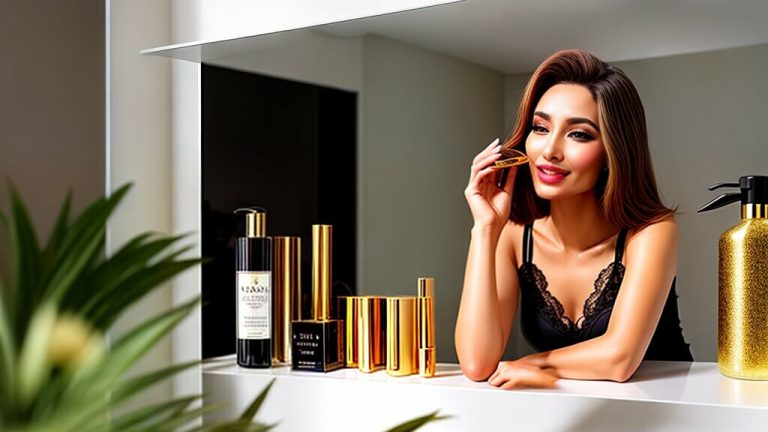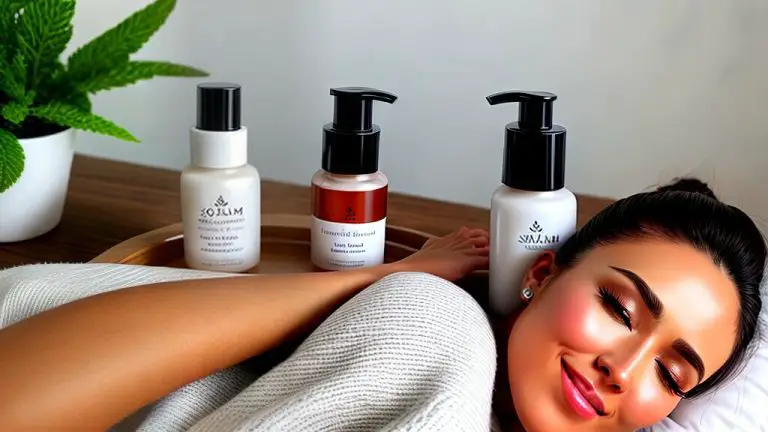How Long to Wait to Apply Moisturizer After Serum | Expert Tips
You’re not alone if you’re wondering about the ideal timing for applying moisturizer after serum. This is a common question among those who take their skincare routine seriously. While the answer might vary slightly depending on your skin type and the specific products you’re using, we’ve consulted with skincare experts to provide the best advice.
It’s important to note that the order in which you apply your serum and moisturizer is just as essential as the timing. Using them incorrectly could render them less effective or even irritating. Let’s dive into how long to wait to apply moisturizer after serum.
Key Takeaways
- Applying moisturizer after serum is a crucial step in a skincare routine.
- The ideal waiting period for applying moisturizer after serum can vary depending on the specific products you’re using, your skin type, and your skin condition.
- Experts recommend waiting at least 30 seconds to a minute before applying moisturizer after serum to allow for proper absorption.
The Proper Order of Applying Serum and Moisturizer
Incorporating serum and moisturizer into your daily skincare routine can do wonders for your skin. But what is the proper order for applying these two products? Many people need clarification about which one comes first, and there is no one-size-fits-all answer.
First, it is essential to understand what each product does. Serums are lightweight products with a high level of concentration of active ingredients, such as antioxidants, peptides, or hyaluronic acid. Serums are designed to pierce deep into the skin to treat specific skin concerns like aging, acne, or dark spots. On the other hand, Moisturizers hydrate and nourish the skin, creating a moisture barrier to lock in moisture and protect against environmental stressors.
Now, let’s talk about the proper order of application. The general rule of thumb is to apply products from thinnest to thickest consistency. This means that serum should go first, followed by moisturizer. Using your serum before moisturizer allows it to penetrate the skin more effectively and deliver maximum benefits.
However, there are a few exceptions to this rule. If your serum is oil-based, it should go after your moisturizer. This is because oil-based products can create a barrier that prevents the moisturizer from penetrating the skin. Additionally, if you have sensitive skin, apply moisturizer first to reduce the risk of irritation.
In summary, the proper order of applying serum and moisturizer is serum first, followed by moisturizer, in most cases. However, if your serum is oil-based, apply it after your moisturizer. If you struggle with sensitive skin, consider using your moisturizer first.
The Ideal Waiting Period for Moisturizer After Serum
After applying serum, it is important to wait a specific amount before applying moisturizer. The ideal waiting period for moisturizer after serum depends on the type of serum and your skin type. As the general rule of thumb, you should wait at least 30 seconds to 60 seconds before applying moisturizer.
| Skin Type | Ideal Wait Time for Moisturizer After Serum |
|---|---|
| Dry Skin | 1-2 Minutes |
| Oily Skin | 30 Seconds – 1 Minute |
| Combination Skin | 1 Minute |
| Sensitive Skin | 1-2 Minutes |
If you use a serum containing active ingredients, like retinol or vitamin C, you may need to wait longer before applying moisturizer. These ingredients require more time to penetrate the skin and work their magic. In this case, waiting 2-3 minutes before applying moisturizer may be necessary.
Always follow the instructions provided with your serum and consider consulting with a dermatologist or skincare expert to determine the best waiting period for your specific skin type and serum.
Benefits of Waiting to Apply Moisturizer After Serum
Waiting a few minutes before applying your moisturizer after the serum has some benefits. Here are some reasons why:
- Better absorption. The skin can absorb the serum well before applying the moisturizer by waiting for a few minutes. This allows the skin to absorb the active ingredients in the serum before being diluted by the moisturizer.
- Enhanced effectiveness. Applying serum before the moisturizer can improve the effectiveness of both products. Serum is designed to deliver active ingredients deeper into the skin, while the moisturizer helps lock in the serum and prevents moisture loss from the skin.
keep in mind that skincare is not a one-size-fits-all approach. What works for someone else may work better for you. So, it’s essential to determine the wait time that works best for your skin.
Factors to Consider When Determining Wait Time
The ideal waiting period for applying moisturizer after serum varies according to several factors. Below are some of the essential considerations to keep in mind when figuring out the wait time for your skincare routine:
Your Skin Type
Skin type plays a crucial role in influencing how long you should wait before applying moisturizer after serum. For instance, if you have dry skin, you might want to wait for around five minutes to allow your serum to fully absorb before moisturizing. On the other hand, if you have oily skin, you can apply moisturizer immediately after your serum without wasting much time.
The Type of Serum You’re Using
The type of serum you’re using can also impact the wait time for applying moisturizer after the serum. If you’re using a lightweight serum, it will absorb faster, and you can apply moisturizer sooner. However, if you’re using a heavy and thick serum, you might want to wait longer to ensure that your skin has absorbed all the active ingredients.
The Humidity and Temperature Levels
Your surroundings’ humidity and temperature levels can affect your skin’s ability to absorb products. If you’re in a dry environment, your skin might require more time to absorb the serum properly, and you might want to wait longer before applying moisturizer. In contrast, if you’re in a humid climate, your skin will absorb products much faster, allowing you to apply moisturizer shortly after your serum.
By keeping all these factors, you can easily determine the ideal wait time for applying moisturizer after serum, making sure that your skin gets the full benefits of your skincare routine.
Expert Tips for Applying Serum and Moisturizer
Now that you understand the proper order for applying serum and moisturizer, it’s time to take a closer look at how to apply them effectively. Here are expert tips to help you get the most out of your skincare routine:
- Start with a clean face: Before applying any products, make sure your face is clean and dry. Use a cleanser and afterwards dry your skin with a clean towel.
- Apply serum first: As mentioned earlier, serum should always be applied before moisturizing. Use a small amount and gently massage the serum into your skin on any areas of concern.
- Wait before applying moisturizer: Depending on the type of the serum you’re using, you should wait for a few minutes before applying moisturizer. Refer to the manufacturer’s instructions or wait 1-2 minutes to be safe.
- Use a pea-sized amount of moisturizer: You don’t need a lot of product to moisturize your face. Use a small amount, about the size of a pea, and apply it evenly over your skin.
- Don’t forget your neck and chest: Many people neglect to moisturize their neck and chest, as these areas are just as important as your face. Apply any remaining product to these areas to keep your skin looking and feeling soft and smooth.
By following these tips, you can apply serum and moisturizer correctly and get the most out of your skincare routine.
Common Mistakes to Avoid
While applying serum and moisturizer may seem like a simple step in your skincare routine, there are some common mistakes that can undermine their effectiveness. By avoiding these common errors, you can make the most of your skincare products and achieve better results.
Using Too Much Product
One of the most common mistakes is using too much serum or moisturizer. While it may seem like using more products will yield better results, it can actually have the opposite effect. Over-applying these products can clog your pores, leaving your skin feeling greasy or sticky. Instead, apply a small amount of each product evenly across your face and neck.
Applying in the Wrong Order
Another common mistake is applying moisturizer before serum. When applied in the wrong order, your products may not absorb properly, rendering them less effective. As a rule of thumb, apply serum first, followed by moisturizer. This will help ensure that both products are fully absorbed and working together to achieve their intended results.
Skipping Sunscreen
While serums and moisturizers are essential steps in your daily skincare routine, they’re not the only products you need to protect your skin. Skipping sunscreen can lead to damage from the harmful UV rays, which might cause premature aging, dark spots, and even skin cancer. Make sure to apply a broad-spectrum sunscreen with atleast SPF 30 every day, even if you don’t plan to spend much time outside.
Understanding the Role of Serum and Moisturizer
Applying serum and moisturizer in the right order is important, but understanding the role of each product in your skincare routine is equally critical. Serum and moisturizer can work together to provide tremendous benefits for your skin, but knowing how they differ and what they can do is essential.
Serum: Serums are lightweight, fast-absorbing, and generally contain active ingredients which target specific skin concerns, like wrinkles, dark spots, and hyperpigmentation. They typically have a thinner consistency than moisturizers and penetrate deeper into the skin.
Moisturizer: As the name suggests, Moisturizers are designed to hydrate and nourish the skin. They form a protective barrier on the skin’s surface, help to lock in moisture, and prevent water loss. Moisturizers are typically thicker than serums and work on the outermost layer of the skin.
By keeping these differences in mind, you can personalize your skincare routine to target your specific skin concerns and needs.
Customizing Your Skincare Routine
Everyone’s skin is unique, so it’s important to personalize your skincare routine to your individual needs. Here are some tips for customizing your routine with serum and moisturizer:
1. Determine Your Skin Type
Before choosing a serum and moisturizer, you need to know your skin type. There are four main types: dry, combination, oily and sensitive. Once you know your skin type, you can select products that are formulated specifically for your needs.
2.Consider Your Skin Concerns
Do you have skin concerns like fine lines, dark spots, or acne? Look for serums and moisturizers that target these issues. For example, a vitamin C serum can brighten skin and reduce the look of dark marks, while a retinol serum can help with fine lines and wrinkles.
3.Layer Products Correctly
The order in which you apply your skincare products can affect their effectiveness. As a general rule, apply your serum first and then your moisturizer. This will allow the serum to pierce deep into the skin and the moisturizer to lock in hydration.
4.Use Products Consistently
For best results, use your serum and moisturizer consistently. Incorporate them into your daily routine, ideally in the morning and at night, to keep your skin looking its best.
5.Experiment and Adjust as Needed
If you’re not seeing the results you want, don’t be afraid to experiment with different products and adjust your routine as needed. Finding the perfect combination for your skin may take some trial and error.
By customizing your skincare routine with serum and moisturizer, you can keep your skin healthy, hydrated, and glowing.
Conclusion
Applying serum and moisturizer is an essential part of any skincare routine. To ensure you are getting the most out of these products, it is important to understand the appropriate order and waiting period between them. Experts recommend waiting at least 30 seconds to 1 minute before applying moisturizer after serum. However, the ideal waiting period may vary depending uponon the specific products you are using and your skin type.
Remember that serums and moisturizers serve different roles in your skincare routine. While the serum is designed to penetrate deeply into the skin and provides targeted benefits such as hydration, brightening, and anti-aging, moisturizer locks in moisture and form a protective barrier for the skin. By customizing your skincare routine and carefully considering the factors that may affect wait time, you can maximize the benefits of both products.
Be sure to also avoid common mistakes such as applying too much product or mixing different formulations together. By following expert tips and taking the time to understand the role of serums and moisturizers in your skincare routine, you can achieve healthy and glowing skin.

I’m Carol Edwards, the force behind SerumDeals.com – your one-stop for all things serum. With over a decade of obsessing over skincare, I’m here to demystify sensational skin. I dig deep, testing serums in action. Beyond the surface, I uncover actual effectiveness. From ingredient breakdowns to real-life testing, my reviews are your trustworthy guide. Whether you’re a skincare rookie or diving into specifics like anti-aging or hydration, I’ve got your back with accurate info. Let’s simplify the serum journey together. SerumDeals.com isn’t just a site; it’s a hub for thriving skincare aficionados. Join me to uncover vibrant skin, one serum at a time.
Glowingly, Carol Edwards







